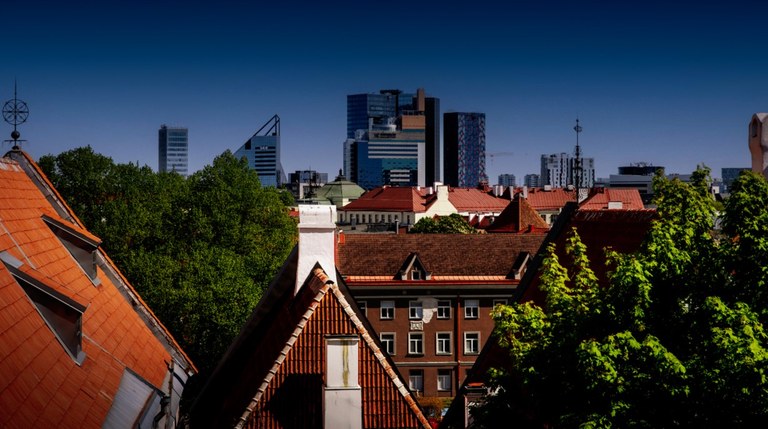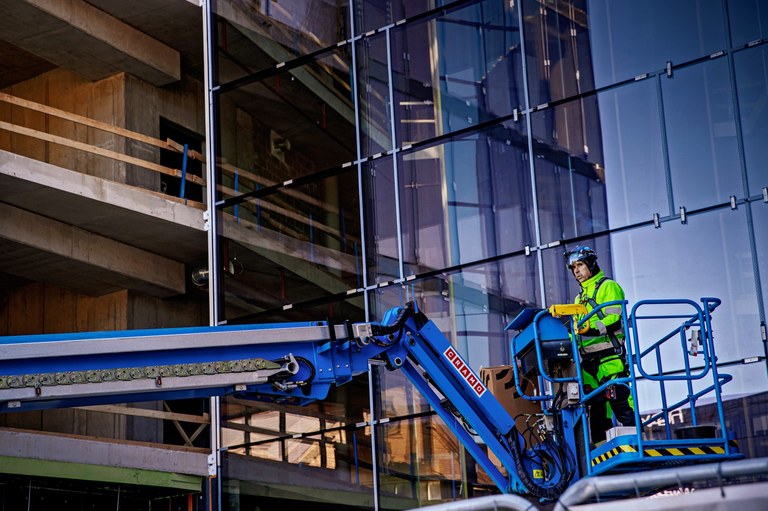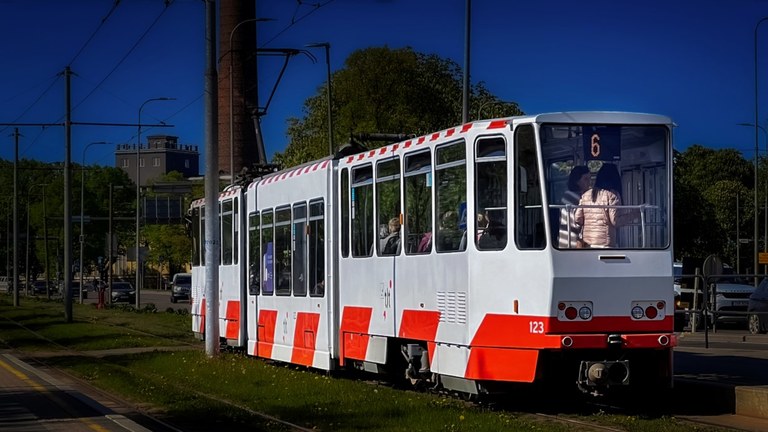Finland still tempting, but many Estonian workers are returning home
Estonia’s capital Tallinn is a charming city that boasts both medieval sights and rapid development. Not much remains from its period as a Soviet republic. Crossing the Gulf of Finland from Helsinki to Tallinn only takes a couple of hours.
There are three companies running ferries between Finland and Estonia, and it is not just Finns who make the crossing to buy cheap alcohol. The shipping companies have increased the number of departures and traffic is back to pre-Covid-19 levels, despite price increases in Estonia. 
Tallinn – modern high-rises are emerging behind the old town.
While tourism remains the main reason for the frequent ferry departures, job commuting also plays a major part – in the opposite direction. It comes from the three Baltic states and from further afield.
Started with the fall of the Soviet Union
There is no exact number for how many foreign workers there are in Finland, but it is believed to be in the tens of thousands. The Covid-19 pandemic changed the traffic, just like it changed the Finnish economy.
The first guest workers were Estonian construction workers who arrived as soon as the borders opened in the late 1980s, as Estonia was gaining independence from the Soviet Union.
Wages were significantly higher and paid in “Western currency". Working conditions and living standards were also better.
Hard work, risk of abuse
Construction work and similar heavy-duty jobs still appear to employ most of the Baltic men who dominate the labour migration to Finland. Health care, cleaning and seasonal work employ a lot of women from the Baltic states.

Construction workers have made up a large part of labour immigration from the Baltics to Finland. But here we see a Finnish construction worker on project in Tallinn.
As migration from the Baltics increased, some worried about wage dumping, crime and trafficking. Today, prostitution rarely figures in debates about labour mobility from the Baltics.
There is a current criminal case in Finland, however, centring on allegations of serious human trafficking. 21 workers are said to have been tricked into working in Finland in slave-like conditions.
Around a dozen Estonians are suspected to have made more than two million euro by exploiting complex regulations, unrealistic dreams and poor language skills. Police believe there might be hundreds of victims who have been working as small business owners but who have been left without pay and benefits.
Worse jobs and worse pay
Both men and women with foreign backgrounds seem to be regularly offered worse jobs than Finns. A survey of trade union representatives done by the Central Organisation of Finnish Trade Unions in the autumn of 2022 showed there were foreign employees in 70 per cent of Finnish workplaces. Three years earlier the number was 56 per cent.
A clear majority of the union representatives said Finns and foreign workers got along well in general. There is a worry among Finnish people that foreign workers are discriminated against and that this leads to worse conditions for Finnish workers as well. There is still a belief among some in the new government coalition member the Finns Party that foreigners take Finnish workers’ jobs for lower pay.
Labour shortages on both sides
Trade unions warn of a two-tier labour market in Finland. They welcome labour immigration but underline that Finnish rules must be followed and Finnish wages paid.
Both Finland and Estonia suffer labour shortages in many sectors. Health sector workers in Finland are in great demand, but language barriers often throw up problems. The hospitality sector also needs more people because so many started working in other sectors during the Covid-19 pandemic.
Unemployment in Estonia has risen to between five and six per cent. Some quote a figure of eight per cent, but that includes a large number of refugees from Ukraine.
Many find jobs themselves in the Nordics or via contacts. It has also become more common to job hunt using branches of Finnish job centres in Tallinn.
Heikki Mäki is a part owner of the Finnish staffing company Finesta, one of the larger players in the Baltics.
Around 800 people find work through his company every year. Finesta operates across the Baltics and the Nordics, providing temporary staff to businesses primarily in the industrial, IT, hotel and restaurant sectors, says Heikki Mäki. 
Heikki Mäki, part-owner of the Finnish staffing company Finesta. Photo: Finesta.
Attempts by the Finnish government – and in particular the Finns Party – to stop immigration does not cause Heikki Mäki to lose sleep. All EU citizens enjoy freedom of movement and are welcome to work in Finland, he points out.
But the government can of course make life more difficult, especially for asylum seekers and workers who arrive from non-EU countries.
The Nordics are popular
Estonian workers do not only look to Finland for work. Norway is also a popular destination for people from the Baltics. But since the country is not an EU member, red tape like work permits make things more difficult.
Neighbouring Sweden is closer geographically and well-known for offering a safe society with good wages.
Seasonal workers have increased in numbers too. Many want to work and spend the winter in Lapplan’s ski resorts and the summer on the coast or in their home country, says Heikki Mäki. Working periods are becoming shorter.
Movement in the opposite direction too
Some Finns and other Nordic citizens also want to try to work in the Baltics, despite lower wages and recent high inflation figures. The price of sugar, for instance, has doubled in one year, according to news reports.

Estonia also tempts workers from other parts of Europe, like Italian restaurant chef Federico Bontorin. Here he is with waiter Laura Vähk at Tule Estonia.
Estonian wages have increased, however, especially in the IT sector, and there is a lot of opportunity to work remotely in that trade, points out Heikki Mäki.
Wages remain low in other trades. In May, Estonia’s social partners agreed to increase the minimum wage by 50 per cent by 2027. Right now, it stands at 725 euro a month, or 4 euro 30 cent an hour.
Estonians returning home
Neighbouring countries can, in other words, offer much in terms of higher wages, when the medium wage for construction workers in Finland, for instance, is 15 to 20 euro an hour.
But the Finnish construction industry, which has used Estonian workers to fill the labour gap, is no longer doing that well. Construction activity has fallen in Finland. The lack of jobs has seen many Estonian construction workers end their memberships in the Finnish Construction Trade Union and go home, says Urmet Aru, who is from Estonia himself.
He has spent the past seven years as a union official at the Finnish Construction Trade Union. He began working as a painter in Finland aged 21.
The union can only help members
Aru knows how big a decision it is to start commuting or to move away from your home country. It can be akin to being at sea. Many work hard for three weeks before having one or two weeks off when they can travel home, away from their often poky accommodation in Finland.
Trade membership is low in Estonia, which is also evident when workers arrive in Finland. Many Estonian workers do not join the union until they discover the need to do so, by which time it is often too late.
If wages are not paid, the employer goes bust or you are threatened with unemployment, you might need legal aid. But the rules say you need at least six months of membership before you can get help from the unemployment fund or the union, underlines Urmet Aru.
Union membership not enough
From a Nordic point of view – where trade union membership stands at nearly 70 per cent in many sectors – the Baltics are in a difficult situation. Several Nordic cooperation projects have tried to increase membership figures in Baltic trade unions.
“The issue was not that we could not get new members to sign up. We just couldn’t keep them. There were no structures in the trade union movement,” explains Jaan-Hendrik Toomel, President of the Estonian Trade Union Confederation EAKL.

Jaan-Hendrik Toomel, President of the Estonian Trade Union Confederation EAKL.
Toomel’s challenge remains to attract and keep more members in Estonia’s trade unions. Fewer than 10 per cent of workers are members, and around 20 per cent are covered by a collective agreement.
It is not clear why Estonians are uninterested in joining a union. Some think it could be historically linked to Soviet times when trade union membership got a bad reputation.
There are differences between sectors, however. There are no unions at all covering agriculture and construction, but transport, education and health are all sectors with high union membership figures – up to 70 to 80 per cent of all workers.
Narrowing wage gap
Wages have risen considerably in Estonia although they are far from even with Nordic medium wages. But the gap has narrowed over the past 30 years, says Jaan-Hendrik Toomel proudly.
Changes in work migration patterns are natural, he believes. There is mobility in both directions. Older Estonian workers are returning home despite lower wages, and younger ones take their place.

Before Toomel became the EAKL President, he worked for the transport union and before that, he was in road construction. But he has never worked in Finland.
He understands why construction workers want to try working in the Nordics and in Germany. Workers in other sectors go elsewhere, like office workers who often choose the UK, explains Toomel.
Migration shows that Estonian wages must increase
Toomel notes that few foreigners want to work in Estonia. They would rather go on to the more attractive Nordic labour market.
Migration is a current trend in the EU. However, it seems many Estonians want to leave. It would, of course, help to increase wages in Estonia. When the wage gap sucks labour out of the country, Estonian employers must pay more. Estonian jobs must become more competitive in order for positions to be filled, points out Toomel. Higher wages also indicate success for the trade union movement.
- Traffic goes both ways
-
Tourism remains the most important source of income for the three ferry operators running operations between Finland and Estonia. But many Estonians also commute to Finland using the ferries. A survey from the autumn of 2022 of FFC's trade union representatives showed there were foreign workers in 70 per cent of workplaces in Finland. Three years earlier there were 56 per cent.
 Follow us on Facebook
Follow us on Facebook
